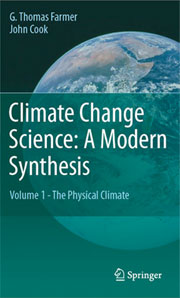Why Choose One Textbook for Introductory Climate Change Science Courses?
A number of instructors involved with teaching an introductory climate change science course currently do not select a textbook for their course. They may select multiple popular books on climate change and global warming and perhaps, in addition, require certain readings from the peer-reviewed literature. There is nothing wrong with this approach and there may be advantages, but let’s first examine a few obvious disadvantages.
First, requiring a number of different books on the subject of climate change may result in greater expense than one textbook although individual textbooks may be very expensive; especially those with abundant color illustrations.
Second, individual popular climate change books may emphasize one aspect of the science and reflect the author’s expertise, bias, or biases. It is difficult to get a comprehensive treatment of climate change science from multiple sources. Many of the popular books emphasize global warming, which is only one aspect of climate change. Global cooling during the last ice age, extreme weather, the behavior of atmospheric and ocean currents, glacial retreat and rising sea levels as well as other factors are also aspects of climate change. These subjects are likely covered by the popular books but in a cursory manner in some.
Third, more than one book required for a course may lead to a disjointed treatment of climate science when climate is a continuum over time, although it may be punctuated by certain extreme events in any given area or period of time.
The advantages to selecting one textbook for a course in climate change science are several.
First, the student has one main source upon which to depend. Of course, this may be enhanced by other readings but the student has additional readings listed in the textbook that can be assigned by the instructor.
Second, the student can benefit from a continuous treatment of the climate system, or as continuous as the climate system will allow. The climate changes that occur over decades, millennia, and millions of years are all important concepts to treat in an introductory climate change science course.
Third, the student will most likely gain confidence in the material as the course progresses with the aid of the instructor referring to sections of the textbook. Lectures may be organized around chapters in the textbook in the order deemed most important by the instructor.
During my days as a student I always felt unfulfilled if the course I was taking did not require me to complete assigned readings from a textbook. The textbook was my “crutch” and the major resource for new information and if I was not required to read it why was I required to buy it? As a university professor I was always over worked and under paid and it was difficult for me to organize lectures around several different sources of information. A textbook provided a central and tangible focus around which I could plan lectures and the course schedule.
 There are a few comprehensive textbooks in climate change science now available to introductory students and we can expect several more in the coming years. John Cook and I do have a favorite textbook in mind that we hope instructors will have a look at and consider for their course; “Climate Change Science: A Modern Synthesis.” Portions of this textbook can be downloaded from Springer at springer.com and purchased directly from Springer or from Amazon, Barnes and Noble, and other booksellers throughout the world. Springer has done an excellent job with the production of the book with special emphasis on the illustrations, quality of the paper and binding.
There are a few comprehensive textbooks in climate change science now available to introductory students and we can expect several more in the coming years. John Cook and I do have a favorite textbook in mind that we hope instructors will have a look at and consider for their course; “Climate Change Science: A Modern Synthesis.” Portions of this textbook can be downloaded from Springer at springer.com and purchased directly from Springer or from Amazon, Barnes and Noble, and other booksellers throughout the world. Springer has done an excellent job with the production of the book with special emphasis on the illustrations, quality of the paper and binding.
Posted by rockytom on Friday, 22 February, 2013
 There are a few comprehensive textbooks in climate change science now available to introductory students and we can expect several more in the coming years. John Cook and I do have a favorite textbook in mind that we hope instructors will have a look at and consider for their course; “Climate Change Science: A Modern Synthesis.” Portions of this textbook can be downloaded from Springer at springer.com and purchased directly from Springer or from Amazon, Barnes and Noble, and other booksellers throughout the world. Springer has done an excellent job with the production of the book with special emphasis on the illustrations, quality of the paper and binding.
There are a few comprehensive textbooks in climate change science now available to introductory students and we can expect several more in the coming years. John Cook and I do have a favorite textbook in mind that we hope instructors will have a look at and consider for their course; “Climate Change Science: A Modern Synthesis.” Portions of this textbook can be downloaded from Springer at springer.com and purchased directly from Springer or from Amazon, Barnes and Noble, and other booksellers throughout the world. Springer has done an excellent job with the production of the book with special emphasis on the illustrations, quality of the paper and binding.
